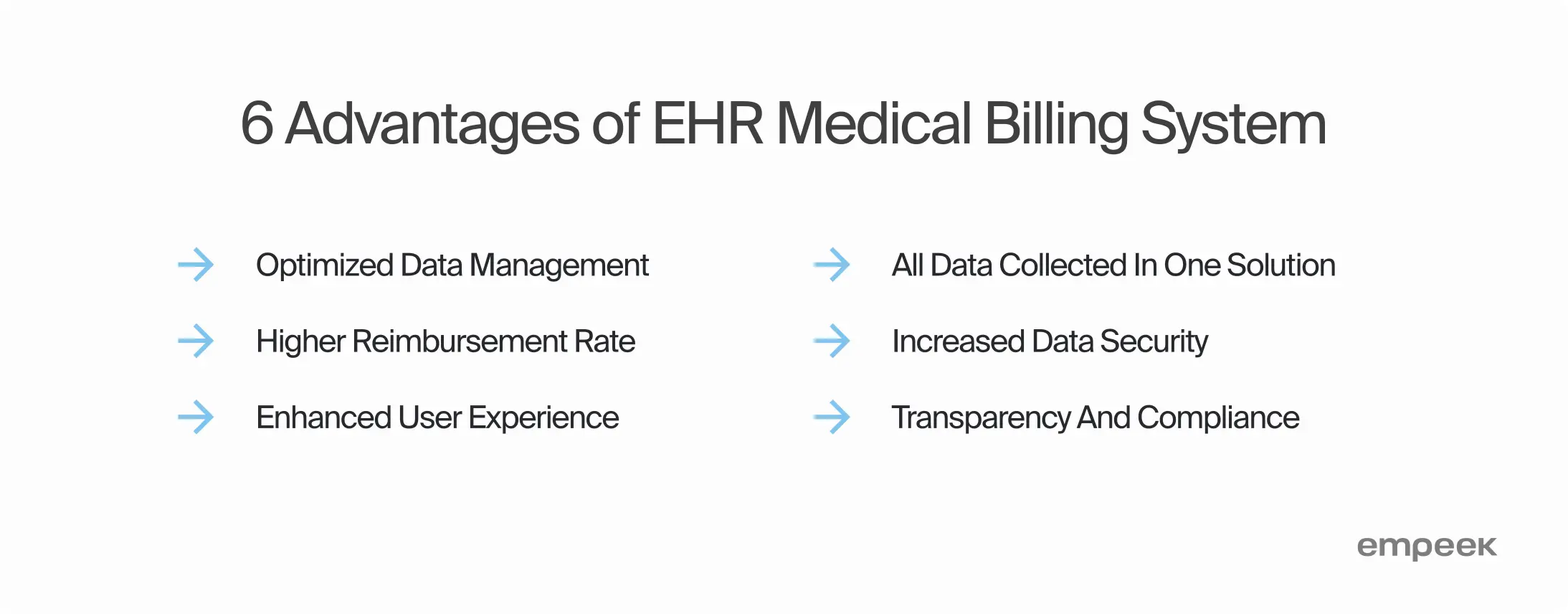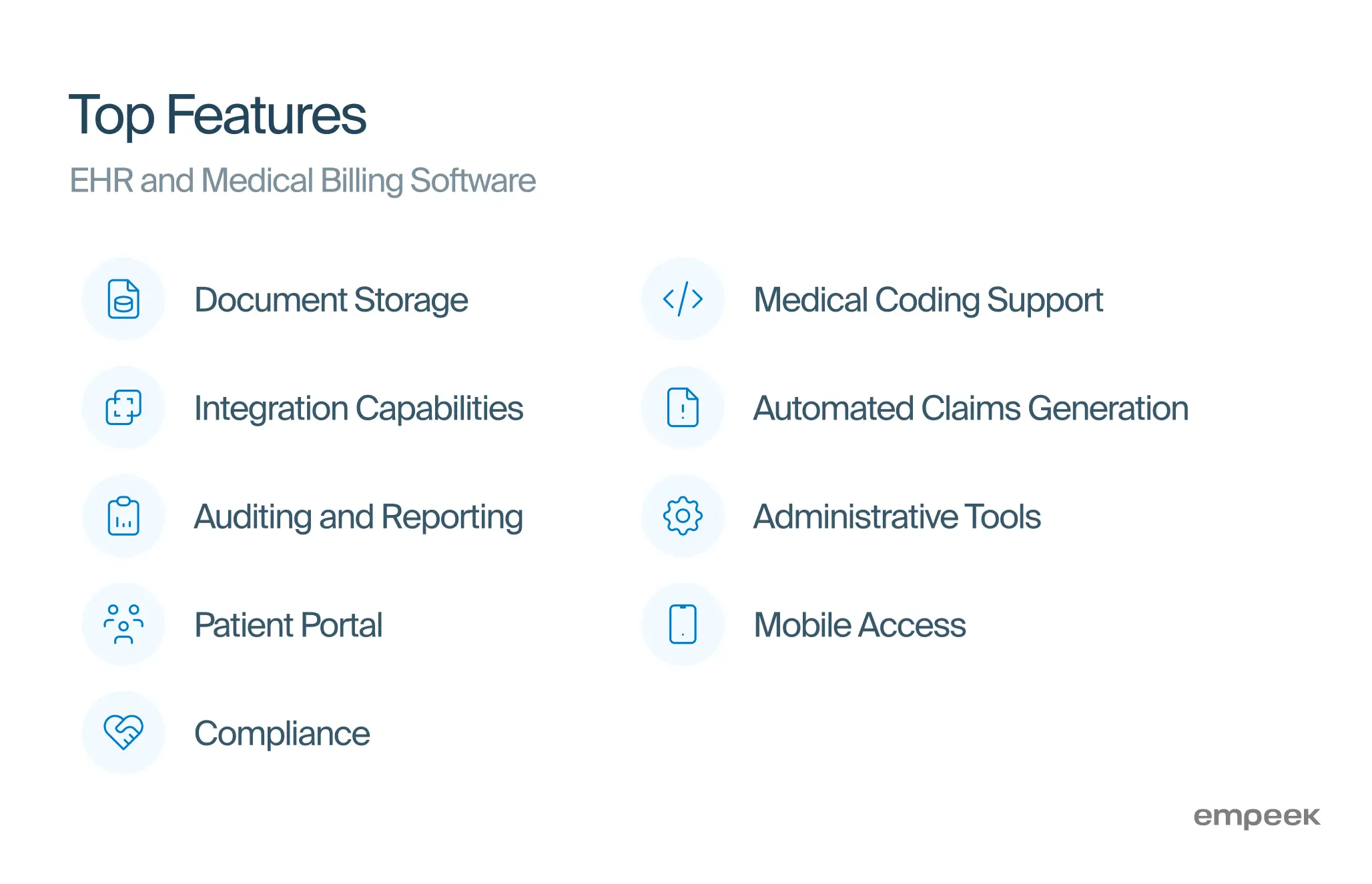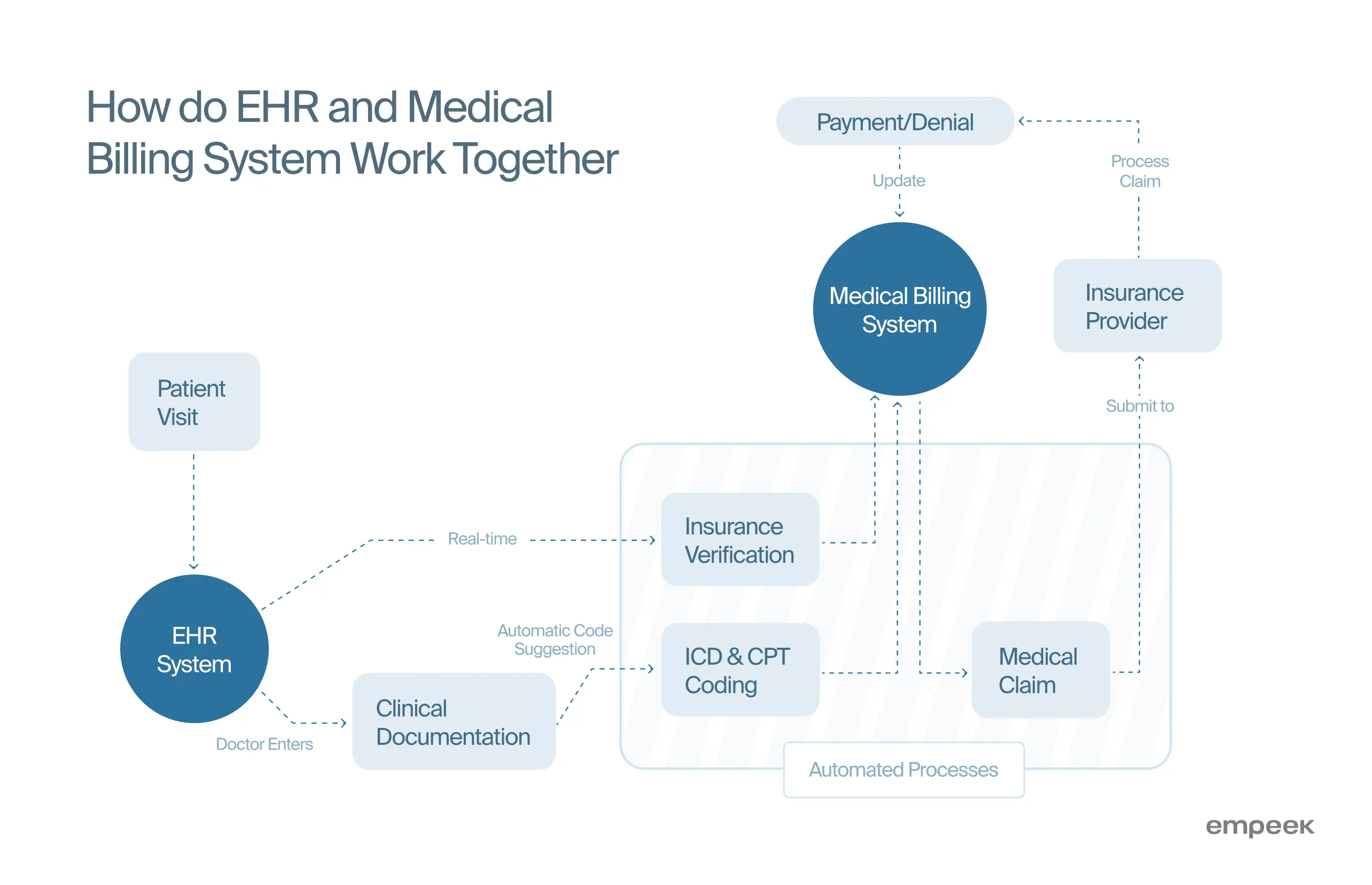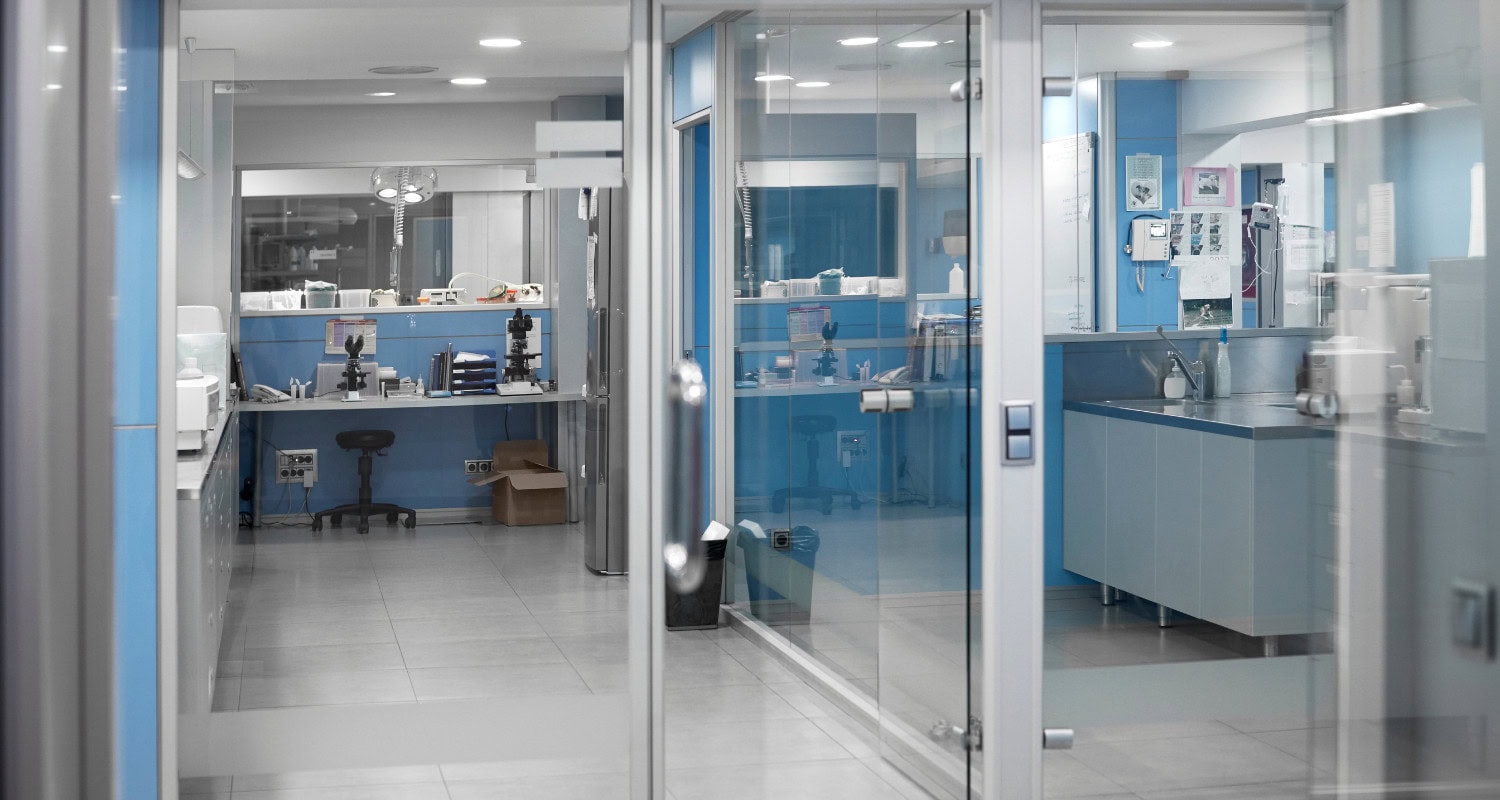The transition from paper to electronic records in healthcare started decades ago, but the COVID pandemic greatly accelerated it. In 2023, 96% of US critical care hospitals used electronic patient records.
Yet after going paperless and emerging into digital transformation, healthcare facilities have faced another problem – software interoperability. As the number of applications used to provide care and manage operations increased, the need to connect and synchronize them smoothly has become sharper than ever.
That’s why facilities using EHR systems seek ways to connect them with billing software. It would enhance data security and optimize accounting and claims processing through automation. Such an integration also reduces manual data entry and increases reimbursement rates. Patient claim management and payment processing become much faster.
Learn what is EHR in medical billing, why, and how to connect the two systems in our post.
What is EHR vs. Medical Billing System
Hospitals connect medical billing software and electronic health records to build a multi-functional EHR billing system that combines the features of these solutions. Since both need the same data to operate, connecting them is a logical step to optimize everything. Billing and EHR systems also boost each other’s functionality, enhancing patient care and the accuracy of billing.
However, these systems also differ in many ways, and you must consider the discrepancies while integrating them.
- Electronic health records (EHR) software stores and manages patient charts with health records, visit details, treatment plans, prescriptions, medications, and other relevant information. Medical staff use EHR software to get a centralized view of the patient. It allows them to make more informed treatment decisions, manage scheduling, and track the success of interventions. Electronic health records also automate many routine tasks, such as record keeping.
- Electronic billing in healthcare automates accounting, billing, and insurance operations. It verifies patient insurance eligibility, informs medical staff of possible reimbursement options, and tracks claims processing and payments. Electronic medical billing software also performs claims scrubbing, audits claims, and fixes coding errors to maximize the chance of reimbursements.
Overall, EHR software can work without integrating billing functionality, while billing services must be connected to medical records to access patient information. That’s why companies that build EHR solutions often include a patient billing system as an add-on.
Why You Need EHR and Medical Billing Software
It might seem an obvious question, but still. Why do healthcare organizations invest in implementing electronic health records and billing software?
First of all, EMR / EHR software is essential to organize patient information and conveniently update it when new events happen. Without it, medical teams must deal with paper records and waste tons of time to find the necessary information. Billing software is another stage of digital transformation as it enables companies to automate payments and claim processing, reducing the workload on their financial departments. Hospitals can focus on helping patients instead of maintaining large administrative teams that keep records and billing in order.
EHR and medical billing system integration doubles the benefits of both systems. It enriches the patients’ records with additional billing information and allows you to reduce manual billing tasks thanks to automated claims processing based on the latest EHR data.
6 Advantages of EHR System Medical Billing
EHR billing system integration takes time since you must align multiple processes and ensure data interoperability. Yet, once you connect EHR and billing, payment processing will become much smoother, bringing many tangible benefits.

1. Optimized Data Management
Paper-based record keeping is no longer feasible due to being time-consuming and likely to result in human errors. Thanks to integrated EHR and billing, you can considerably reduce mistakes and speed up claim submission and processing since the same data is used across multiple systems.
Discover Rules of Remote Patient Monitoring Billing and Reimbursement
2. Higher Reimbursement Rate
An integrated EHR/EMR billing system provides coding suggestions, making the medical staff less likely to make mistakes or miss critical information. As a result, insurers are more likely to accept your medical claims, which improves first-pass claim and net collection rates. Thanks to optimized revenue cycle management, your organization becomes more financially stable and profitable.
3. Enhanced User Experience
By integrating EHR and billing software into one system, you make their functionality more convenient to use. Staff can do everything through the same medical billing EHR interface, which simplifies their lives and eliminates the need to constantly switch between multiple tools.
4. All Data Collected in One Solution
The use of EHR/EMR in medical billing gives medical staff a unified view of patients and their insurance opportunities. Doctors can pick the most suitable treatment options based on what the patient can afford. EMR billing service integration also improves collaboration between medical and administrative teams since they share data in real time.
5. Increased Data Security
A survey conducted by Savvy Cooperative involving 1,000 patients revealed apprehensions about data privacy safeguards and a lack of clarity regarding entities with access to personal health information. Approximately 75% of patients expressed worries about safeguarding the privacy of their health data, with only 20% indicating a clear understanding of the extent of companies and individuals with access to their information. An integrated electronic medical billing system gives you more control over user roles to ensure authorized access to medical information. PHI security improves, people feel safer about their data, and you can achieve HIPAA compliance.
6. Transparency and Compliance
Integrated EHR and billing make your organization’s workflows more visible and easily trackable. You can see what has happened with each patient while they have been getting services within your facility. Such transparency allows you to conduct medical billing audits smoothly and achieve regulatory compliance, which always requires proper record-keeping.
Core Features to Have in an Integrated EHR and Medical Billing Software
As a two-in-one system, EMR in medical billing can have extensive functionality and many add-ons. Therefore, if you decide to build a custom solution, you should analyze your organization’s needs to decide how the medical billing system will look. Below, we provide some core features to include in a medical billing EHR.

Document Storage
Integrated EHR and billing software must securely store all financial documents and treatment details that patients and the medical facility share with each other. It’s essential to successfully pass regular audits and streamline document management and record keeping.
Medical Coding Support
An EHR billing software must support ICD 10, HCPCS, or CPT coding, depending on what system your facility uses. These codes are used to classify and mark different diseases and health conditions, describe procedures, and specify services. They allow healthcare organizations to translate the provided services into amounts to be paid.
Integration Capabilities
Integrated EHR billing and coding are still two different systems that must have high interoperability to exchange data and operate smoothly. Moreover, you might need to expand them with additional tools like telehealth, remote patient monitoring, etc. That’s why we recommend using secure API as an optimum solution for healthcare software integration.
Automated Claims Generation
Automation is one of the core capabilities of medical billing EHR software. Such a system must automatically generate claims and bills based on source data. You can also automate claim submission, coding, patient invoicing, and denial management. Additionally, medical billing systems detect unpaid or underpaid bills, which negatively affect revenue.
Read Insurance Claims Processing Automation and Its Impact
Auditing and Reporting
Besides data gathering and storing, EHR billing software must turn it into informative reports summarizing your financial operations. You will have better control over your organization’s profitability and be able to easily pass audits by providing clear documentation to regulatory bodies.
How Do EHR and Medical Billing System Work Together
Once you integrate EHR and medical billing software, most operations happen automatically or at least become much simpler. Here is how it happens.
When doctors check a patient, they enter the necessary details, such as symptoms, test results, and treatment details, into an EHR and billing system. The software suggests suitable ICD and CPT codes based on the entered data to minimize errors and assist medical staff. Staff can also verify a patient’s insurance coverage in real time.
Now that the related treatment expenses are clear, the EHR and billing system forwards a medical claim to the insurance provider.

Get Engineering Help From Empeek
Empeek is a healthcare engineering provider that builds custom solutions and helps companies integrate third-party software. We will carefully analyze your business requirements and needs at the project start to recommend an optimum software implementation option.
Learn more about our work through our case study on EHR and telehealth implementation. Contact us today for a free consultation.
Final Thoughts
Integrated EHR and medical billing systems optimize patient tracking, document management, reimbursements, and other operations within a hospital system. That’s why you shouldn’t hesitate to use such a combination. The main decision is whether to choose a ready-made solution that may be cheaper but less efficient or prefer custom software development.
Need a solution that’s 100% tailored to your business? Our custom software development team can build your EHR billing system from the ground up or integrate billing features into your existing EHR software.








